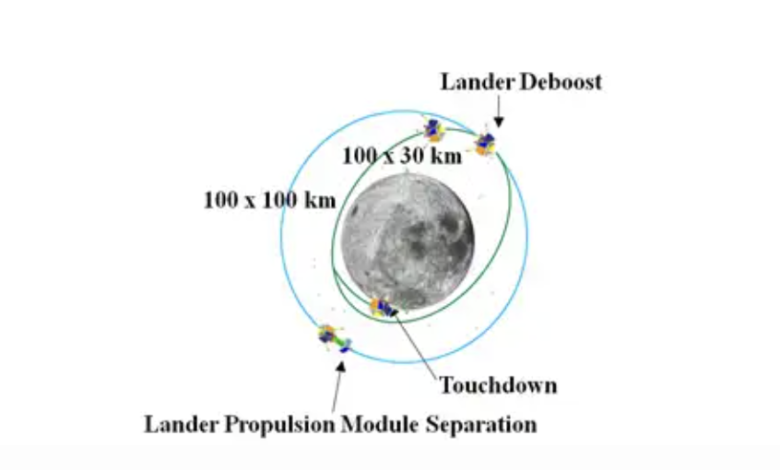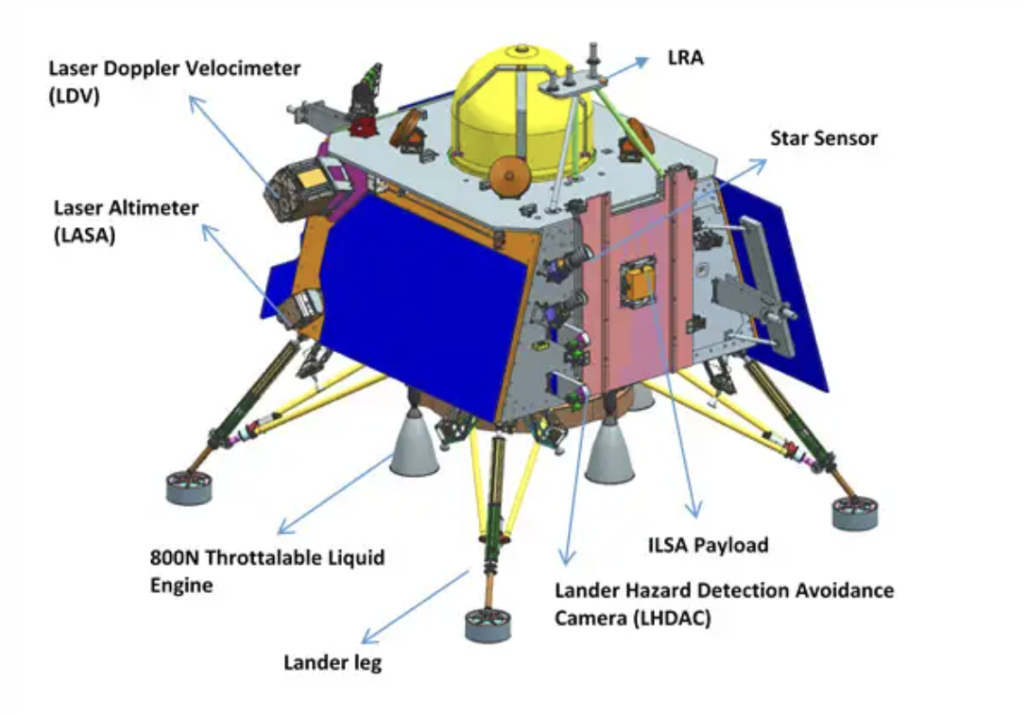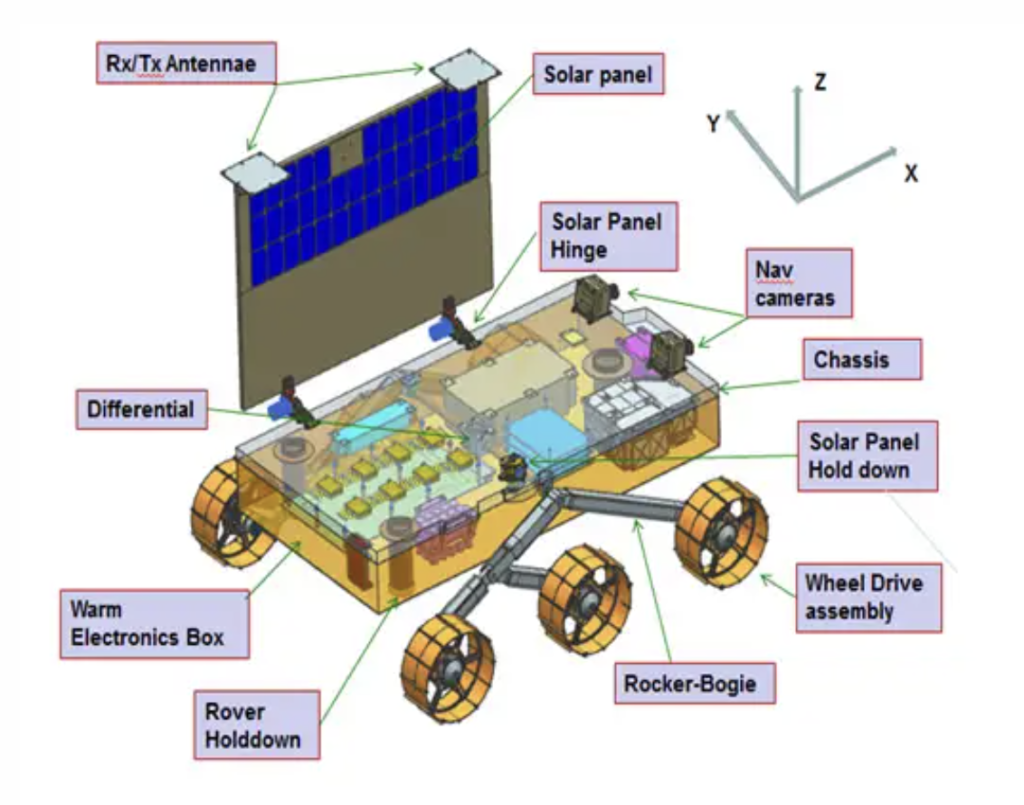ISRO’s Chandrayaan-3 Nears Historic Lunar Landing Today at 6 PM, All Systems Green

The eyes of the world are riveted on the imminent lunar triumph as the Indian Space Research Organisation (ISRO) readies to execute a momentous landing on the moon today, scheduled for 6 PM. Verified reports from ISRO’s official sources have confirmed to NewsStation that every intricate parameter of the Chandrayaan-3 mission is currently surpassing expectations, and the team is fully poised for the scheduled lunar landing.
Chandrayaan-3, the successor to the triumphant Chandrayaan-2, represents a pivotal chapter in space exploration, showcasing ISRO’s prowess in accomplishing a secure landing and autonomous navigation on the lunar terrain. The mission profile features a sophisticated Lander-Rover combination, aimed at demonstrating a seamless chain of events from touchdown to mobility on the moon’s surface.
Prepared for launch by the powerful LVM3 vehicle from the Satish Dhawan Space Centre SHAR in Sriharikota, Chandrayaan-3’s propulsion module is entrusted with the task of ferrying the Lander and Rover configurations to a lunar orbit at a distance of 100 kilometers above the moon. Of particular interest, the propulsion module carries the Spectro-polarimetry of Habitable Planet Earth (SHAPE) payload, a cutting-edge instrument designed to capture spectral and polarimetric data of Earth from the unique perspective of lunar orbit.
Drilling deeper into the mission’s scientific payloads, the Lander module is equipped with a comprehensive suite of instruments. The Chandra’s Surface Thermophysical Experiment (ChaSTE) will measure temperature and thermal conductivity, the Instrument for Lunar Seismic Activity (ILSA) is tasked with seismicity measurements, and the Langmuir Probe (LP) aims to estimate plasma density fluctuations. NASA’s passive Laser Retroreflector Array has been seamlessly integrated into the Lander to support lunar laser ranging studies.
Complementing the Lander’s capabilities, the Rover’s payload includes the Alpha Particle X-ray Spectrometer (APXS) and the Laser Induced Breakdown Spectroscope (LIBS). These sophisticated tools are tailor-made to provide a detailed elemental analysis of the lunar environment, enriching our comprehension of its geological composition.
An ISRO spokesperson declared, “Chandrayaan-3 marks a pivotal advancement in lunar exploration. The mission’s objectives encompass a secure and soft landing, autonomous rover movement, and the execution of on-site scientific investigations.” The multi-faceted module configuration, which integrates the Lander, Rover, and Propulsion Module, promises an unprecedented degree of functionality.
The core of Chandrayaan-3 consists of an indigenous Lander module (LM), Propulsion module (PM), and a Rover, all synergistically designed to drive the development and exhibition of novel technologies imperative for interplanetary missions. The Lander module showcases the capability to softly land at precise lunar coordinates and deploy the Rover, which will conduct real-time chemical analysis of the lunar surface as it roves. Both the Lander and the Rover harbor scientific payloads devised to execute experiments directly on the lunar terrain.
The Propulsion Module (PM) has been strategically developed to shepherd the Lander module from its injection by the launch vehicle to its final orbit around the moon, 100 kilometers above its surface. This module also boasts an additional scientific payload, intended for operation after the separation of the Lander module. The designated launcher for Chandrayaan-3 is LVM3 M4, charting a course that will position the integrated module in an Elliptic Parking Orbit (EPO) spanning approximately 170 x 36500 kilometers.
Chandrayaan-3’s mission objectives are unequivocal:
- Demonstrate a safe and gentle lunar landing.
- Showcase autonomous rover mobility on the moon’s surface.
- Conduct on-site scientific experiments to enhance lunar knowledge.
Chandrayaan-3 integrates an array of advanced technologies within its Lander, including laser and RF-based altimeters, laser Doppler velocimeters, laser gyro-based inertial referencing systems, and an array of thrusters for precise propulsion control. These are supplemented by cutting-edge navigation, guidance, and control systems, hazard detection and avoidance mechanisms, and an intricate landing leg mechanism.
To validate these advanced technologies in Earth’s conditions, ISRO has meticulously orchestrated several specialized Lander tests, all executed with remarkable success. These tests encompass integrated cold tests for assessing sensor and navigation performance via helicopter platforms, integrated hot tests involving closed-loop performance assessments with sensors, actuators, and guidance systems using tower cranes, and rigorous Lander leg mechanism tests on a lunar simulant test bed simulating various touchdown scenarios.
The comprehensive specifications for Chandrayaan-3 are as follows:
- Mission Life (Lander & Rover): Approximately one lunar day (~14 Earth days).
- Landing Site (Prime): 4 km x 2.4 km at coordinates 69.367621 S, 32.348126 E.
- Science Payloads:
- Lander:
- Radio Anatomy of Moon Bound Hypersensitive Ionosphere and Atmosphere (RAMBHA).
- Chandra’s Surface Thermophysical Experiment (ChaSTE).
- Instrument for Lunar Seismic Activity (ILSA).
- Laser Retroreflector Array (LRA).
- Rover:
- Alpha Particle X-Ray Spectrometer (APXS).
- Laser Induced Breakdown Spectroscope (LIBS).
- Propulsion Module:
- Spectro-polarimetry of Habitable Planet Earth (SHAPE).
- Lander:
- Two Module Configuration:
- Propulsion Module (Transports Lander from launch to lunar orbit).
- Lander Module (Accommodates Rover within the Lander).
- Mass:
- Propulsion Module: 2148 kg.
- Lander Module: 1752 kg, including a 26 kg Rover.
- Total: 3900 kg.
- Power Generation:
- Propulsion Module: 758 W.
- Lander Module: 738W, with bias.
- Rover: 50W.
- Communication:
- Propulsion Module: Communicates with IDSN (Indian Deep Space Network).
- Lander Module: Communicates with IDSN and Rover. Chandrayaan-2 Orbiter also serves as a contingency link.
- Rover: Communicates exclusively with the Lander.
- Lander Sensors:
- Laser Inertial Referencing and Accelerometer Package (LIRAP).
- Ka-Band Altimeter (KaRA).
- Lander Position Detection Camera (LPDC).
- Lander Hazard Detection & Avoidance Camera (LHDAC).
- Laser Altimeter (LASA).
- Laser Doppler Velocimeter (LDV).
- Lander Horizontal Velocity Camera (LHVC).
- Micro Star sensor.
- Inclinometer & Touchdown sensors.
- Lander Actuators: Four reaction wheels (10 Nms & 0.1 Nm).
- Lander Propulsion System: Bi-Propellant Propulsion System (MMH + MON3), featuring four 800 N throttleable engines & eight 58 N throttleable engines; equipped with Throttleable Engine Control Electronics.
- Lander Mechanisms:
- Lander leg.
- Primary & Secondary Rover Ramps.
- Rover.
- ILSA, Rambha, and Chaste Payloads.
- Umbilical Connector Protection Mechanism.
- X-Band Antenna.
- Lander Touchdown Specifications:
- Vertical Velocity: Not exceeding 2 m/sec.
- Horizontal Velocity: Not exceeding 0.5 m/sec.
- Slope: Not exceeding 12 degrees.
The scientific payloads planned for Chandrayaan-3’s Lander Module and Rover have clear-cut objectives:
Lander Payloads:
- Radio Anatomy of Moon Bound Hypersensitive Ionosphere and Atmosphere (RAMBHA): Featuring the Langmuir probe (LP), this payload aims to measure the near-surface plasma density of ions and electrons and monitor their temporal variations.
- Chandra’s Surface Thermophysical Experiment (ChaSTE): This payload undertakes thermal property measurements of the lunar surface in the vicinity of the polar region.
- Instrument for Lunar Seismic Activity (ILSA): Targeting seismicity around the designated landing site, this payload aims to map the structure of the lunar crust and mantle.
- Laser Retroreflector Array (LRA): A passive experiment intended to unravel the dynamics of the lunar system.
Rover Payloads:
- Laser Induced Breakdown Spectroscope (LIBS): This advanced tool performs qualitative and quantitative elemental analysis, aiding in the derivation of chemical composition and providing insights into mineralogical structure to enhance our understanding of the lunar surface.
- Alpha Particle X-ray Spectrometer (APXS): Designed to determine the elemental composition (Mg, Al, Si, K, Ca, Ti, Fe) of lunar soil and rocks surrounding the landing site.
Propulsion Module Payload:
- Spectro-polarimetry of Habitable Planet Earth (SHAPE): This scientific payload holds the potential to facilitate future discoveries of smaller planets through reflected light observations, enabling the exploration of various exoplanets for signs of habitability or the presence of life.
As the world anticipates this monumental feat, ISRO’s Chandrayaan-3 readies itself to etch its mark in space exploration history, pushing the boundaries of human achievement and fostering a deeper connection with the cosmos.






